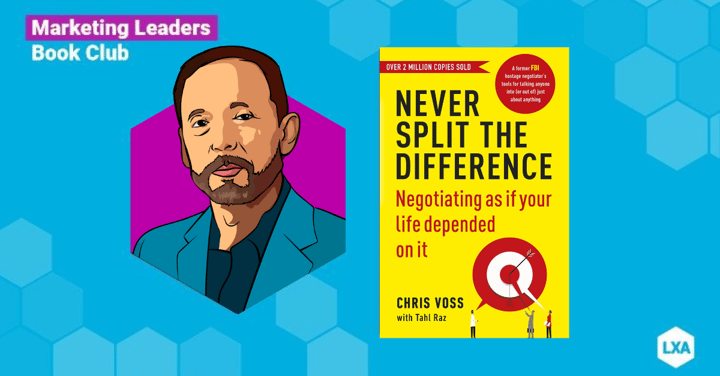
We're bringing you the best insights written in the world of marketing today, thanks to our sponsors at Treasure Data.
Tactical empathy is the name of the game for Chris Voss. This is the key to success in very dangerous negotiations according to Chris, a technique which he describes as "emotional intelligence on steroids"

All of this, and the content within Never Split the Difference calls on Chris' FBI career as a top hostage negotiator. It equips readers with the skills in negotiation to secure business deals, taking these abilities from the FBI into the business world.
He suggests that logic and reason are not really effective in producing successful or productive negotiations, instead emphasising the need for tactical empathy. This is due to the complex and difficult nature of intense negotiations. It's all about seeing your sparing partner as a human, not a robot.
Why Never Split The Difference is Vital for Any Modern Marketer
Chris suggests that negotiations should begin with the premise that people want to be understood and accepted. The easiest way to achieve this is by listening and listening intensely. This demonstrates empathy and a willingness to understand.
On top of this is being adaptable. Negotiators need to be ready for surprises and use their skills to reveal the surprises they are certain to exist. It's important to question the assumption that others accept on faith or in arrogance. This would allow a negotiator to remain emotionally open to all possibilities and adapt to a fluid situation.
Remember, negotiation is not a battle, but a process of discovery. You should be aiming to uncover as much info as possible.
The book also encourages its reader to slow down. This means your partner will build trust with you, instead of the rapport and trust being destroyed.
Chris also details three voice tones available to negotiators:
- The late-night FM DJ voice. This is used selectively to make a point. It's all about inflecting your voice downwards, keeping it calm and slow, which creates a feeling of authority.
- The positive/ playing voice. This should be the default voice. It's easy-going, good-natured, light and encouraging.
- The direct and assertive voice. This should be used rarely, as it can cause pushback.
Tactical empathy is also about understanding the feelings of another but also understanding these feelings to increase your influence, uncovering potential pathways and emotional obstacles.
Chris also details the benefits of the Akerman Model, an offer-counteroffer method. This is an effective system for beating the usual bog-standard bargaining dynamic, which often just meets in the middle.
The process has six steps:
- Set your target price (your goal);
- Set your first offer at 65 per cent of your target price;
- Calculate three raises of decreasing increments (to 85, 95, and 100 per cent);
- Use lots of empathy and different ways of saying “No” to get the other side to counter before you increase your offer;
- When calculating the final amount, use precise, non-round numbers like, say, $37,893 rather than $38,000. It gives the number credibility and weight; and
- On your final number, throw in a non-monetary item (that they probably don’t want) to show you’re at your limit.
About the Author
Chris Voss was a member of the New York City Joint Terrorism Task Force from 1986 to 2000, and was involved in monitoring the New York City landmark bomb plot after investigating the 1993 World Trade Centre Bombing.
In 1992 he received hostage negotiation training at the FBI Academy and then spent 24 years working in the FBI Crisis Negotiation Unit. He was the FBI's chief international hostage and kidnapping negotiator from 2003 to 2007.
After working on more than 150 international hostage cases, he retired from the FBI in 2007 and founded the Black Swan Group, which serves as a consultancy and trainer for businesses and individuals on negotiation skills.
He also became an adjunct professor at Georgetown University's McDonough School of Business and a lecturer at the USC Marshall School of Business.
Top Takeaways
- A negotiator must be a "decision architect". This means they have to design the verbal and nonverbal elements of the negotiation to gain both consent and execution.
- Create the illusion of control. Calibrated questions have the power to educate your counterpart about what the problem is rather than causing conflict by telling them what it is.
- Negotiating begins with listening, validating the other person, and creating trust
- Use mirrors to encourage the other person to empathise with you in return
- Giving someone's emotion a name gets you close to someone without asking about external factors you know nothing about
- "No" provides a great opportunity for you and the other party to clarify what you really want by eliminating what you don't want.
Link to purchase page
Purchase Never Split the Difference on Amazon and Audible
Other Books You May Be Interested In
- Thinking, Fast and Slow - Daniel Kahneman
- The Choice Factory - Richard Shotton
- How to Make the World Add Up - Tim Harford
- Made to Stick - Chip and Dan Heath
We're bringing you the best insights written in the world of marketing today, thanks to our sponsors at Treasure Data 👇

Stay tuned for more! 📖📚
